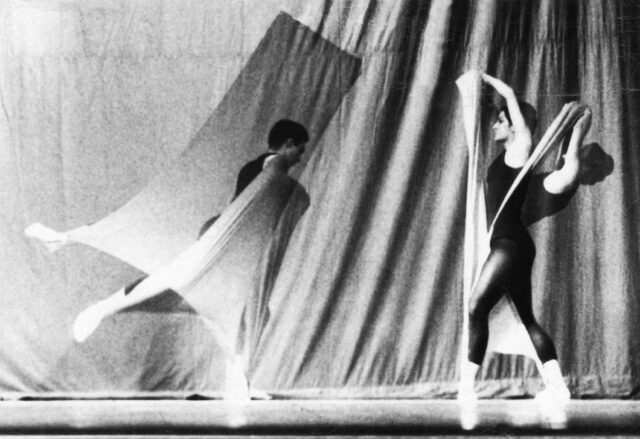

Rosemarie Castoro: Paintings 1964-1966
April 20–July 22, 2023
101 Spring Street
New York, NY
Judd Foundation is pleased to present Rosemarie Castoro: Paintings 1964-1966 at 101 Spring Street in New York. Curated by Flavin Judd, Artistic Director of Judd Foundation, and organized in partnership with the Estate of Rosemarie Castoro, and Thaddaeus Ropac gallery. The exhibition features five paintings by Rosemarie Castoro, an artist who worked across painting, sculpture, dance, photography, graphic design, and poetry.
The works included in Rosemarie Castoro: Paintings 1964-1966 reflect Castoro’s primary formal interests of the mid-1960s which art historian Tanya Barson has described as the exploration of, “simple and direct compositions of bold, flat, shapes isolated on an unmodulated ground.”1 The serial permutations of paintings, such as Red Blue Green Purple, 1964, can be viewed as abstract forms or signs with a choreographic orientation that are articulated in infinitely repeated patterns. Castoro, like Donald Judd, rejected the oversimplification of an artist’s work into categories. Instead, she worked across mediums while maintaining a lifelong commitment to abstraction. Castoro’s paintings from this time precede her later work in performance, poetry, and what she called “paintingsculpture” and “sculptural drawing.” Of note are her freestanding walls, such as Foyer from 1971, a work in gesso and graphite on multiple Masonite panels that directly engage sculpture and architecture. In the late 1970s, her sculptural work took on totemic qualities as seen in a body of work titled Flashers, which included a permanent installation of a large-scale outdoor work in concrete.
Rosemarie Castoro: Paintings 1964-1966 situates Castoro’s work within the context of the radical dance practices of Simone Forti and Yvonne Rainer, and the experimentation of visual artists Louise Bourgeois, Eva Hesse, and Agnes Martin. Accompanying the exhibition is a newly commissioned text by independent scholar Rachel Stella.
In conjunction with the exhibition, Judd Foundation will host a conversation between Wendy Perron and Yvonne Rainer at 101 Spring Street on Wednesday, May 10 at 6:00pm which will explore the relationship between dance and visual arts in the 1960s.
Rosemarie Castoro: Paintings 1964-1966 is part of Judd Foundation’s ongoing exhibition series in New York. Since 2015, the Foundation has organized exhibitions of works by Alvar Aalto, John Chamberlain, Dan Flavin, Felix Gonzalez-Torres, Donald Judd, Yayoi Kusama, Richard Long, David Novros, James Rosenquist, Lauretta Vinciarelli, and Meg Webster. These exhibitions continue a practice begun by Judd of using the ground floor as a public exhibition space.
[1] Tanya Barson, “Rosemarie Castoro 1964–79: An Obstacle Course for a Dancer?” in Rosemarie Castoro: Focus at Infinity (Barcelona: Museu d’Art Conemporani de Barcelona, MACBA, 2017), 24.
Rosemarie Castoro (1939–2015) formulated her unique artistic idiom within the context of Minimalist and Conceptual art in 1960s New York, sharing a SoHo loft with ex-husband and fellow artist Carl Andre that became a social hub for creatives, including Lawrence Weiner, Richard Long, and Sol LeWitt. While studying graphic design at the Pratt Institute, Brooklyn, she became involved with the New Dance Group and later appeared in several performances with famed Minimalist choreographer Yvonne Rainer. Defying easy categorization, Castoro called herself a “paintersculptor,” and a dancer’s awareness of space informed her works, emphasized in the performative Polaroids she took of herself interacting with them in her studio.
From 1964 onwards, Castoro created systematic works exploring color and structural compositions in highly innovative experimentations, like her Y-Unit, Interference, and Inventory paintings and drawings. In 1968 – a time of political unrest in the United States – Castoro abandoned color and started to engage with Conceptual art, street works, concrete poetry and Post-Minimalist sculpture. From the 1970s until the final years of her life, Castoro focused on sculptural experimentation, creating organic shapes that represented a parallel to the experimentation of Eva Hesse and Louise Bourgeois. Castoro had a tendency to blend media, investing her works with a bodily dimension that is rarely present in the mathematical principles underlying Minimalism. Neither wholly Minimalist nor a self-avowed feminist, her work transgressed boundaries and metamorphosed into an erotically charged language that communicates a sense of empowered female identity. The famed feminist critic and curator Lucy R. Lippard later identified her as a figure who “subverted or overrode Minimalism on its own turf.”
Born in Brooklyn, Castoro lived and worked in New York on Spring Street in Lower Manhattan until her death in 2015. Major posthumous career retrospectives have been held at the Museum of Modern and Contemporary Art, Geneva (2019) and the Museum of Contemporary Art, Barcelona (2017). Her work has also been featured in group exhibitions at the Los Angeles County Museum of Art (2017); National Gallery of Art, Washington, D.C. (2016); Museu de Arte Moderna Rio de Janeiro (2014); Albright-Knox Art Gallery, Buffalo, New York (2012); and MoMA PS1, Queens, New York (2003).

Rosemarie Castoro: Paintings 1964-1966 is made possible with support from Thaddaeus Ropac gallery. Additional support provided by Catherine Walsh.